THE SAMURAI AND THE SACRED
S TEPHEN T URNBULL
CONTENTS
INTRODUCTION
Fud, the immoveable one, shown holding a sword in his right hand and a rope in his left hand while surrounded by flames. This statue is in the courtyard of the Yashimaji near Takamatsu.
In the year 1592, as the Japanese invasion fleet was about to set sail to attack Korea, there was a slight pause in the proceedings while Matsuura Hin Shigenobu (15491614) performed a brief religious ritual. Dressed in his finest robes and holding aloft a heihaku (a symbolic offering made of paper), he climbed up on to the raised deck of his ship and turned to face in the general direction of the distant Iwashimizu shrine, which was dedicated to Hachiman, the kami (god) of war. He bowed three times. Guns were fired and his followers gave three war cries. Shigenobus commander-in-chief, Toyotomi Hideyoshi (153698), sent a messenger to enquire after the reason for the noise. Shigenobu reported back that on board his ship they were paying their respects to the Hachiman shrine in acknowledgement of the similar occasion in ancient times when the Empress Jing had led an invasion of Korea. Toyotomi Hideyoshi was delighted.
had led an invasion of Korea. Toyotomi Hideyoshi was delighted.
This little ceremony, performed at the start of what was to prove one of Japans cruellest and most disastrous wars, provides a neat illustration of the subtle relationship between the samurai and the sacred. At the heart of the interaction taking place on board Shigenobus ship is the worship of and reverence for one of the kami, the numinous entities that are the focus of worship in the religious system that is known as Shint. Kami is often translated simply as god, and the word Shint means the way of the gods.
Since the 8th century AD Japan has often been referred to in official documents as the land of the gods (shinkoku), and any interested visitor to Japan nowadays cannot help being struck by the apparent all-pervasiveness of the sacred in modern Japanese life. Shint shrines (jinja) large and small appear to be everywhere, from household altars to huge architectural complexes. Shrines also exist as tiny memorials on beaches, where anonymous victims of drownings are enshrined, and can even be found within the precincts of the Buddhist temples, which provide another very prominent visual reminder of the enduring religious life of the Japanese people. But sacred objects do not end there. One comes across little stone statues by the roadside, while the courtyards of temples and shrines appear to house fortune-tellers booths. Wandering monks dressed in full medieval robes turn up in the doorways of restaurants to bless the diners. New cars are ceremoniously purified, and the spires of Christian churches may occasionally be seen protruding from hillsides behind shrines to Confucius.
This situation of apparent harmony has been dubbed the Japanese religious supermarket, where, with some notable exceptions, not only have the various religious traditions intermingled throughout history, but Japanese people today also seem happy to participate in rituals from different systems. As the popular saying tells us, the Japanese are born Shint and die Buddhist, with perhaps a wedding in a Christian church somewhere along the journey of life. This accommodative approach to religion has been seen as an example of an assimilative tendency in Japanese culture, whereby newly introduced traditions did not uproot the indigenous but were invariably assimilated into a kind of homogeneous tradition which might itself be called Japanese religion.
Matsuura Shigenobus spontaneous act of devotion to the kami as he was about to set off to war provides an illustration of how religion has permeated Japanese society throughout history. The world of the samurai and the world of the sacred were not opposing entities. Instead, the two aspects coalesced into one unitary world view where the denizens of the spirit world interacted with men. The kami may have been mysterious, but they were also accessible and could be moved to anger or compassion according to whether they were honoured or neglected.
Shigenobu has prudently honoured one very powerful kami by his prayers, and will set off on his expedition confident that Hachiman will aid him. Here we see an interesting emphasis being laid upon precedent and tradition. Shigenobu wishes his military expedition to be a success, so he invokes the example of a previous triumph in the same direction by choosing to honour one kami in particular. Hachiman is the deified spirit of Emperor Ojin, who lived between AD 201 and 310 according to the traditional reckoning. When his mother, Empress Jing , carried out her own legendary invasion of Korea she was pregnant with the future emperor and put a stone in her sash to delay his birth. Hachiman, as Japans primary god of war, was therefore a very suitable kami to invoke before an invasion. The imperial connection further exemplifies one other very important characteristic of Shint: its close links with the emperors of Japan, who claimed a direct descent from Amaterasu, the Sun-Goddess the greatest of all the kami.
, carried out her own legendary invasion of Korea she was pregnant with the future emperor and put a stone in her sash to delay his birth. Hachiman, as Japans primary god of war, was therefore a very suitable kami to invoke before an invasion. The imperial connection further exemplifies one other very important characteristic of Shint: its close links with the emperors of Japan, who claimed a direct descent from Amaterasu, the Sun-Goddess the greatest of all the kami.
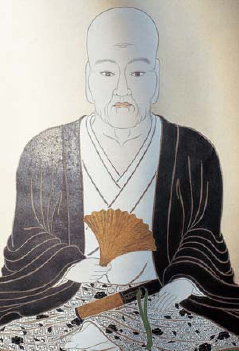
Matsuura Hin Shigenobu, daimy of Hirado, who prayed for victory before taking part in Hideyoshis invasion of Korea in 1592. From a painted scroll in the Matsuura Historical Museum, Hirado.
It is also noticeable that Shigenobus offering to Hachiman is a very low-key and informal affair. As on so many other occasions throughout history, we see less evidence of a religious service in the Christian sense than an example of an individual turning to the kami in times of personal need. Nowadays people visit Shint shrines at certain times, such as for festivals and personal rites of passage, as well as casually dropping in to pray. Matsuura Shigenobu is praying for victory in battle: a common occurrence in the history of the samurai that often involved a visit to an important shrine where a particular kami had been enshrined. When Oda Nobunaga (153482) set out on the march that led to his victory at the battle of Okehazama in 1560, he wrote a prayer for victory and deposited it at the Atsuta shrine near present-day Nagoya. Takeda Katsuyori made a point of visiting the shrine of his father, the late Takeda Shingen, before setting off on the fateful campaign that ended in his defeat at the battle of Nagashino in 1575. In the case cited above, Shigenobu is unable to visit the Iwashimizu shrine, which is located hundreds of miles away near Kyto, so he bows in its direction.
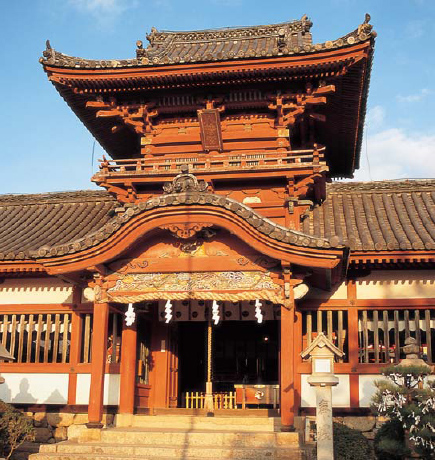
The Isaniwa shrine in Dgo Onsen, Matsuyama, dedicated to Hachiman, the important











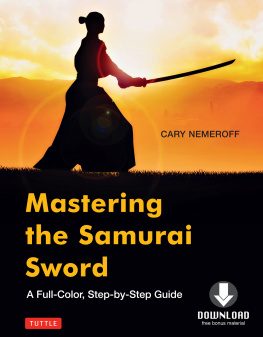

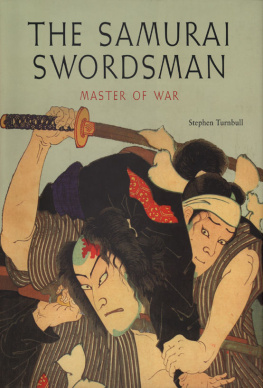
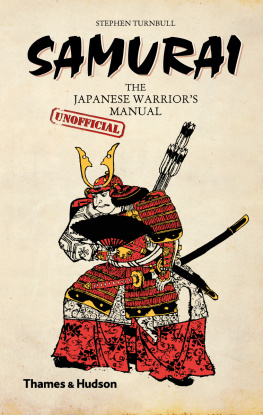
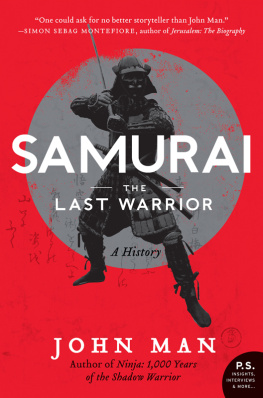


 had led an invasion of Korea. Toyotomi Hideyoshi was delighted.
had led an invasion of Korea. Toyotomi Hideyoshi was delighted.
